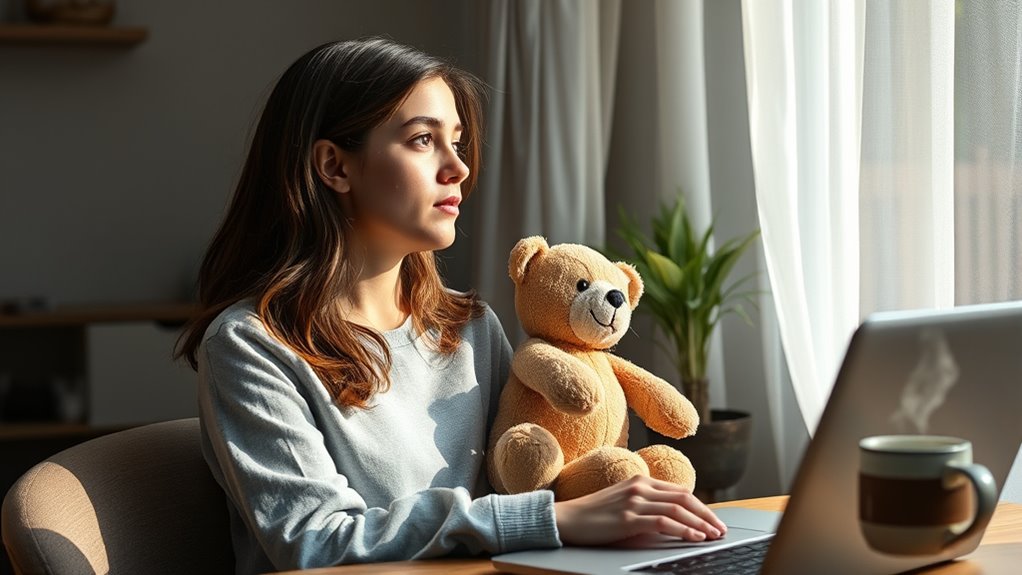To manage separation anxiety when returning to the office, start by practicing mindfulness techniques like deep breathing and quick meditation breaks throughout your day. Focus on positive visualizations and affirmations to ease worries. Establish routines that promote calm, such as stretching or checking in with yourself regularly. Recognizing your triggers and gently redirecting your focus can help reduce feelings of stress. Continue exploring ways to stay balanced and confident as you adapt to your work routine.
Key Takeaways
- Practice mindfulness techniques like deep breathing and observation to stay grounded during stressful transitions.
- Establish a routine that includes short mindfulness exercises at home and work to ease separation anxiety.
- Visualize positive outcomes and focus on affirmations to reduce worries about leaving loved ones or pets.
- Recognize personal triggers and pause intentionally to manage feelings of overwhelm before returning to the office.
- Use calming strategies such as gentle redirection and self-compassion to support emotional regulation during the transition.

Have you ever felt overwhelmed when leaving your pet or loved one alone? That knot in your stomach, the racing thoughts, and the guilt that lingers as you head out the door can be tough to shake. Returning to the office after time away can trigger similar feelings of separation anxiety, both for you and your pet. The good news is, you can manage these emotions effectively with some practical strategies. Workplace mindfulness, in particular, can ground you during stressful moments, helping you stay focused and calm. By practicing simple mindfulness exercises—like deep breathing or mindful observation—you can reduce your anxiety and approach your day with greater clarity.
Incorporating anxiety management techniques into your routine can make a significant difference. Start by recognizing your triggers and intentionally pausing when feelings of unease surface. For example, take a few slow, deep breaths, focusing on the sensation of air filling your lungs and then slowly exhaling. This not only calms your nervous system but also brings you into the present moment, making the separation feel less overwhelming. If your mind races with worries about your pet or loved one, try to replace those thoughts with affirmations or positive visualizations. Reminding yourself that you’ve made arrangements for their care can ease your mind and help you focus on your work. Additionally, understanding industry trends can help you stay confident and prepared for your workday ahead.
Another helpful approach is to establish a routine that promotes workplace mindfulness. Before diving into tasks, take a few minutes to stretch or do a quick meditation. These small moments of mindfulness can reset your emotional state and prevent anxiety from building up throughout the day. Throughout your workday, check in with yourself periodically—are you feeling tense or distracted? If so, pause, breathe, and gently redirect your focus back to your current activity. These simple anxiety management techniques are easy to implement and can make your return to the office less stressful.
Frequently Asked Questions
How Long Does Separation Anxiety Typically Last?
Separation anxiety usually lasts a few weeks as you adjust routines and become more comfortable in the workplace. To ease this progression, focus on establishing consistent routines and communicate your needs for workplace accommodations. Over time, you’ll find it easier to manage anxiety, and your confidence will grow. Remember, patience is key—most people adapt within a month or so, especially when supportive measures are in place.
Can Medication Help With Workplace Separation Anxiety?
Medication can help with workplace separation anxiety by reducing symptoms and making it easier to cope. Its effectiveness varies based on individual needs, so consulting a healthcare professional is essential. Alongside medication, therapy options like cognitive-behavioral therapy (CBT) can provide long-term strategies for managing anxiety. Combining these approaches often yields the best results, helping you regain confidence and adapt more smoothly to returning to the office.
Are There Specific Signs That Separation Anxiety Is Worsening?
Yes, you can tell if your separation anxiety is worsening by noticing physical symptoms like increased heart rate, sweating, or stomach discomfort, along with emotional signs such as heightened worry, irritability, or difficulty concentrating. If these signs intensify or persist, it’s a clear indication that your anxiety is worsening. Pay attention to these signals and consider seeking support to manage your feelings effectively.
How Can I Support a Coworker Experiencing Separation Anxiety?
You can support a coworker experiencing separation anxiety by fostering open workplace communication and offering peer support. Check in with them privately, listen empathetically, and reassure them they’re not alone. Encourage them to share their feelings and suggest manageable steps to ease their progression back. Your understanding and encouragement create a safe space, helping them feel more comfortable and supported during this adjustment period.
Is Separation Anxiety More Common in Certain Age Groups?
Separation anxiety is more common in certain age groups, especially children going through developmental stages, where age-related triggers like starting school or new routines can heighten feelings of fear. However, adults can also experience it, often due to significant life changes or stress. Understanding these age-related triggers helps you recognize that separation anxiety isn’t limited to any one age, and support varies based on developmental stages.
Conclusion
Remember, just like Odysseus faced the storms to return home, you can navigate these feelings. Embrace small victories and trust that this shift is part of your journey. Separation anxiety may tug at your heart, but it also signals how much you care. With patience and courage, you’ll find your rhythm again. Soon, the office will feel less like a stranger’s house and more like your own familiar haven.










